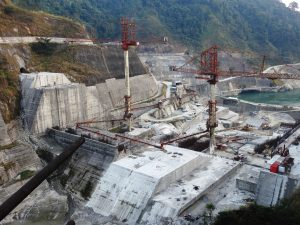By Rajeev Bhattacharyya
 A hydel dam in India’s Northeast that was stalled following large scale protests is now scheduled for completion in three-and-a-half years.
A hydel dam in India’s Northeast that was stalled following large scale protests is now scheduled for completion in three-and-a-half years.
Straddled across the twin states of Assam and Arunachal Pradesh, the Lower Subansiri hydroelectric project was stuck for the past eight years due to various issues. All the hurdles were removed following a judgment by the National Green Tribunal (NGT) that dismissed a petition that had raised concerns over the project.
The Lower Subansiri project, which will produce 2000 megawatts of power, is being developed as part of India’s hydropower program to generate a total of 50,000 megawatts. Among the Central Electricity Authority (CEA)’s prefeasibility studies of 162 projects, a total of 5,600 megawatts was planned on the Subansiri river across three components. The river originates in Tibet and is one of the largest tributaries of the Brahmaputra.
The run-of-the-river project is expected to incur an expenditure of over $2.8 billion. It will consist of a concrete gravity dam, which will be 116 meters high from the river bed level and 130 meters from the foundation with a length of 284 meters.
Concerns Over Safety Measures
The construction of Lower Subansiri dam had started in 2005 and was due to be completed in 2010. However, the project was delayed due to protests over its environmental impact. Work came to a grinding halt 2011 when anti-dam activists set up roadblocks to prevent the shipment of machinery.
Protesters alleged that the dam would not be able to resist earthquakes in a zone that is highly prone to seismic activity. Leaders at the vanguard of the agitation had cited numerous instances of flooding in Assam whenever water was released from the Ranganadi dam in Arunachal Pradesh and Kurishu in Bhutan.
In 2008, a committee was formed comprising experts from Gauhati University, Dibrugarh University, and Indian Institute of Technology to examine the feasibility of the project. It said in its report that the project was not appropriate in such a geologically and seismologically sensitive location. One of its recommendations was a redesign of the dam by reducing the height and production capacity.
The findings of this report further convinced civil society groups leading the protests about the dangers from the dam in the downstream region, which mainly covers Lakhimpur and Dhemaji in Assam.
Committees Fuel Controversy
Subsequently three more committees were constituted to break the stalemate, but this only fueled more controversy. In March 2011, a two-member expert committee was formed by the Planning Commission, which voiced some concerns of the anti-dam activists, but it also objected to a few findings of the earlier expert committee.
A month later, the National Hydro Power Corporation (NHPC), which is entrusted to construct the dam, formed a Joint Steering Committee for remedial measures in the downstream areas. In 2015, as part of its negotiations with agitators, the ministry of power also appointed a Project Oversight Committee to reexamine the project.
Meanwhile, the project became a subject of litigation in 2013, when Assam Public filed a suit in the National Green Tribunal challenging the recommendation of both the Joint Steering Committee and the Expert Group Committee. Almost four years later, the court passed a judgment directing the government to constitute a committee of three experts to evaluate the project.
Months after the committee submitted a report approving the dam, the the National Green Tribunal dismissed the petition to reconstitute the committee and ordered the resumption of construction.
Safety Measures Incorporated
Government officials have been quoted by the media as saying that the the dam has been designed to withstand seismic activity up to a magnitude of 8 on the moment magnitude scale, which makes it one of the strongest dams in India.
As per the new design, the width of the dam has been increased from 171 meters to 271 meters in order to make it safer and an additional cut-off wall would be built downstream.
NHPC has clarified that all technical issues have been resolved as per the suggestions of an expert committee to prevent adverse downstream impact. A package of $66 million has been earmarked for the downstream region, which would include river bank protection and erosion control measures up to 30 kilometers from the dam.
Further, for development work in the downstream, the Gujarat-based Institute of Rural Management (IRMA) has been engaged as consultant for implementation of sustainable livelihood strategies. A recent booklet released by NHPC lists another ten schemes planned for the benefit of the local population.
Rajeev Bhattacharyya is a senior journalist in Assam, India.
No comments:
Post a Comment